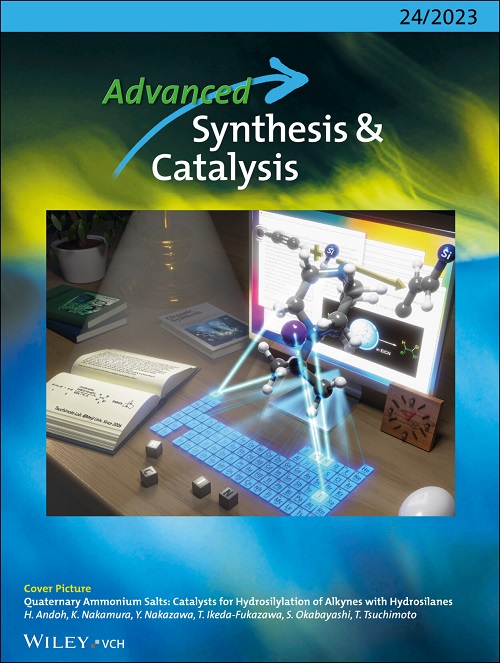[Graduate School of Science and Technology] ANDOH Hiroki’s paper, for which he served as the primary author, has been selected as the cover picture of the international academic journal Adv. Synth. Catal., edition 24, 2023
Dec. 04, 2023

A paper for which ANDOH Hiroki, a doctoral student in the Applied Chemistry Program at the Graduate School of Science and Technology, currently enrolled in the Organic Reaction Control Laboratory (Professor TSUCHIMOTO Teruhisa), served as the primary author, has been selected as the cover picture of the international academic journal Adv. Synth. Catal., (impact factor = 5.376) edition 24, 2023. This research was conducted in collaboration with a research group led by Professor FUKAZAWA Tomoko from the Department of Applied Chemistry, School of Science and Technology, Meiji University, and Lecturer OKABAYASHI Satoki from the Department of Applied Chemistry for Environment, School of Biological and Environmental Sciences, Kwansei Gakuin University. We would like to take this opportunity to express our gratitude to everyone who participated in the study.
Silicon is the second most abundant element in the Earth’s crust, following oxygen, and the development of methodologies and technologies utilizing raw materials containing silicon is crucial for the advancement of a sustainable chemical industry. The addition of hydrosilane (H-Si) to alkyne (C≡C), which has a triple bond between carbons, yields alkenylsilane (HC=CSi) with 100% atomic efficiency (a waste-free reaction without by-products), finding applications in various fields. This reaction, called hydrosilylation of alkynes, has been mainly carried out using rare and expensive metals such as Pt, Rh, and Pd as catalysts. In contrast, the Tsuchimoto Group demonstrated for the first time in the world that an organic compound called a quaternary ammonium salt can serve as a catalyst for this reaction without using an expensive metal as a catalyst. This catalyst is easily prepared by simply mixing of 2-Iodopropane and DABCO (1,4-Diazabicyclo[2.2.2]octane, an amine derivative as a nitrogen compound) in the reaction system. This eliminates the need for any prior preparation, making the reaction exceptionally simple and accessible. This catalyst can be used to synthesize a series of alkenylsilanes in high yield and with high stereoselectivity in a variety of substrate combinations. An additional attractive feature of this catalyst is that it is a dream catalyst that can be reused many times by extracting the products from the reaction vessel after the reaction and reintroducing the substrate and solvent, leaving the catalyst in the reaction vessel to carry on the reaction repeatedly.
The corresponding paper summarizes the results of the above research, and the cover picture is an image of the situation. The image depicts a world in which a catalyst as an organic compound made from 2-Iodopropane and DABCO powerfully catalyzes the hydrosilylation of alkynes.
Cover Picture :
https://onlinelibrary.wiley.com/doi/10.1002/adsc.202301235
Article :
Quaternary Ammonium Salts: Catalysts for Hydrosilylation of Alkynes with Hydrosilanes
https://onlinelibrary.wiley.com/doi/10.1002/adsc.202300423
≪Japanese version≫
Silicon is the second most abundant element in the Earth’s crust, following oxygen, and the development of methodologies and technologies utilizing raw materials containing silicon is crucial for the advancement of a sustainable chemical industry. The addition of hydrosilane (H-Si) to alkyne (C≡C), which has a triple bond between carbons, yields alkenylsilane (HC=CSi) with 100% atomic efficiency (a waste-free reaction without by-products), finding applications in various fields. This reaction, called hydrosilylation of alkynes, has been mainly carried out using rare and expensive metals such as Pt, Rh, and Pd as catalysts. In contrast, the Tsuchimoto Group demonstrated for the first time in the world that an organic compound called a quaternary ammonium salt can serve as a catalyst for this reaction without using an expensive metal as a catalyst. This catalyst is easily prepared by simply mixing of 2-Iodopropane and DABCO (1,4-Diazabicyclo[2.2.2]octane, an amine derivative as a nitrogen compound) in the reaction system. This eliminates the need for any prior preparation, making the reaction exceptionally simple and accessible. This catalyst can be used to synthesize a series of alkenylsilanes in high yield and with high stereoselectivity in a variety of substrate combinations. An additional attractive feature of this catalyst is that it is a dream catalyst that can be reused many times by extracting the products from the reaction vessel after the reaction and reintroducing the substrate and solvent, leaving the catalyst in the reaction vessel to carry on the reaction repeatedly.
The corresponding paper summarizes the results of the above research, and the cover picture is an image of the situation. The image depicts a world in which a catalyst as an organic compound made from 2-Iodopropane and DABCO powerfully catalyzes the hydrosilylation of alkynes.
Cover Picture :
https://onlinelibrary.wiley.com/doi/10.1002/adsc.202301235
Article :
Quaternary Ammonium Salts: Catalysts for Hydrosilylation of Alkynes with Hydrosilanes
https://onlinelibrary.wiley.com/doi/10.1002/adsc.202300423
≪Japanese version≫
Related links


